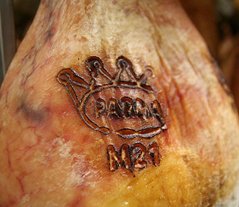 There is a city in Italy, known all over the world as the king of Italian hams, synonymous with quality. The city is Parma, in Emilia Romagna, a really pretty town. Around Parma, there are eleven officially recognized production areas for the ham: the famous Prosciutto di Parma. Only hams coming from these areas are DOP, i.e. denomination of product origin, and have the right to be marked with the traditional logo: a five-pointed crown, which can be seen wherever in Italy and abroad. Of course, area of origin is not enough to guarantee the originality of the ham. Another important factor is the pigs.
There is a city in Italy, known all over the world as the king of Italian hams, synonymous with quality. The city is Parma, in Emilia Romagna, a really pretty town. Around Parma, there are eleven officially recognized production areas for the ham: the famous Prosciutto di Parma. Only hams coming from these areas are DOP, i.e. denomination of product origin, and have the right to be marked with the traditional logo: a five-pointed crown, which can be seen wherever in Italy and abroad. Of course, area of origin is not enough to guarantee the originality of the ham. Another important factor is the pigs.
Animals must have been fed with quality foods, such as maize, barley, and milk whey left over from Parmigiano cheese production (another gem in the Italian gastronomy.) Pigs must be nine months old minimum and the weight must be at least 150 Kg. Hams are then placed in refrigerators where they are cooled to 0°. The particular shape of Parma ham (Prosciutto di Parma), similar to a chicken leg, is important for the salt processing.
It is this process that gives to the ham its special flavor. No kinds of additives, chemicals or preserving agents are used. After a period of rest, the hams are washed in warm water. Then, they are hung in a warehouse for seasoning. Humidity is very important and it is controlled, opening and closing windows that face the rows of hams.
Very important is the last phase of testing, when experts insert a needle in the ham to check the consistency first and then aroma. As a matter of fact, the needle is made of horse bone, which has the property of absorbing aromas and releasing them easily.
The experts sniff the needle and confirm that the ham is ready to be sold.
If not, it is necessary to wait till the right moment. Or, if something, according to the experts, went wrong during the process, the whole ham is discarded.
The producer’s consortium, which guarantees the product quality since beginning of 1960, counts189 members who produce nine million Parma hams a year, exported all over the world.
Every year, the festival of ham is held in September. Visitors can sample different cuts of ham, together with bread and wine.
To read more about Emilia Romagna: Food & Wine Information & Culinary Tours .